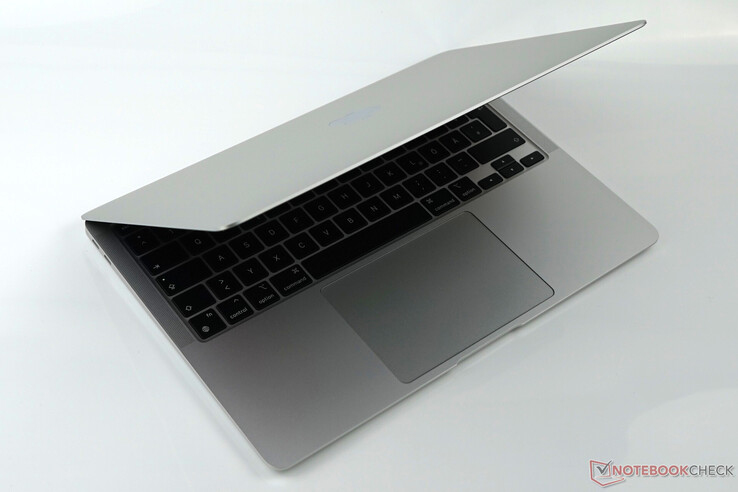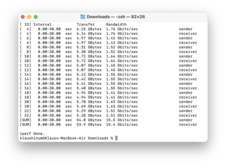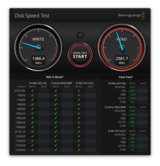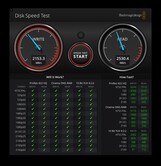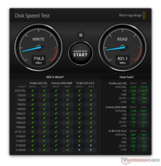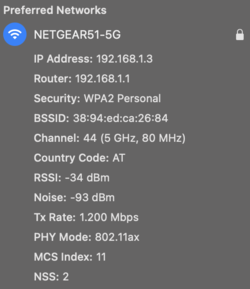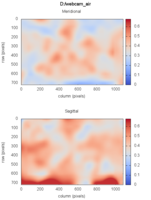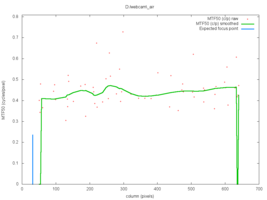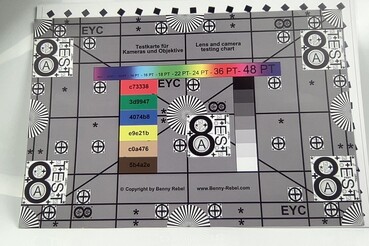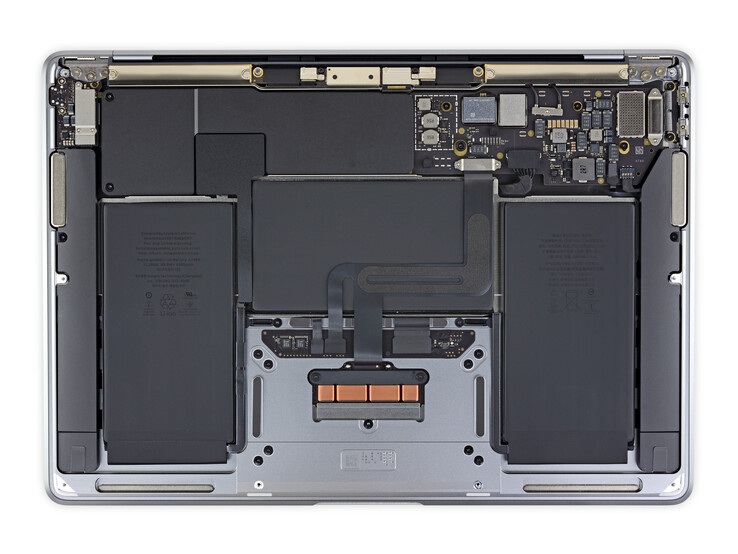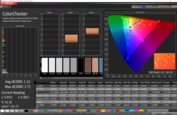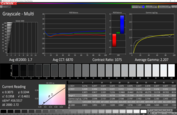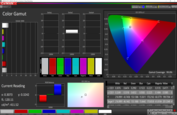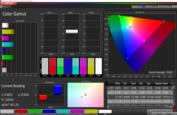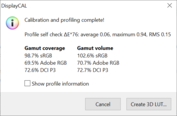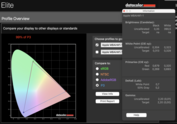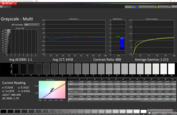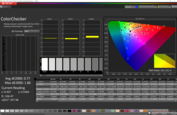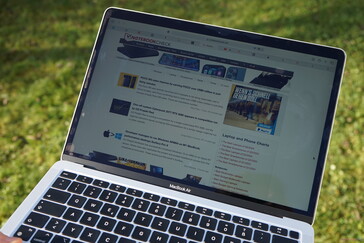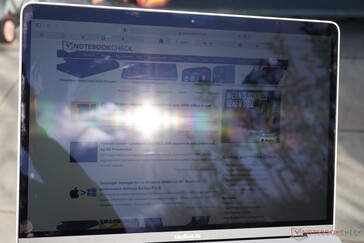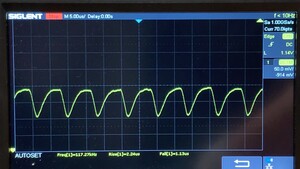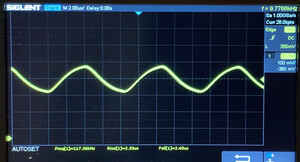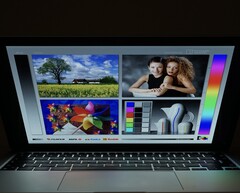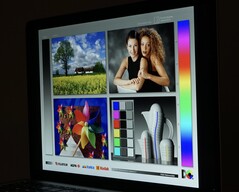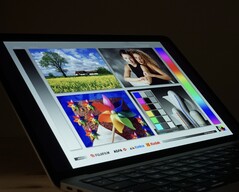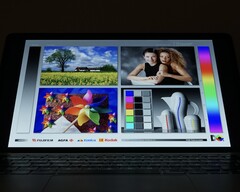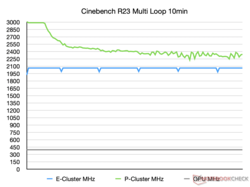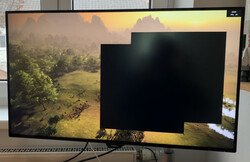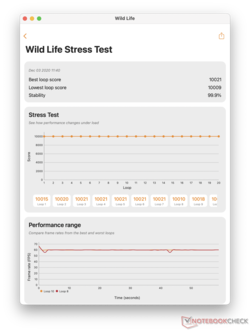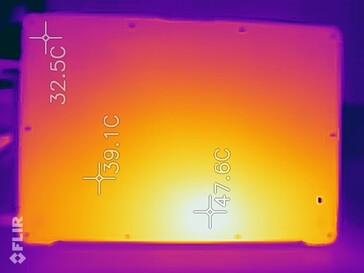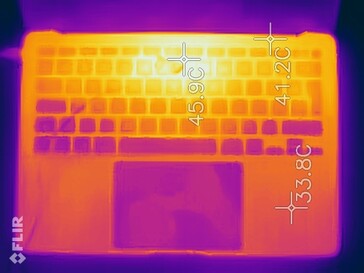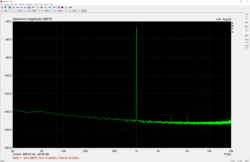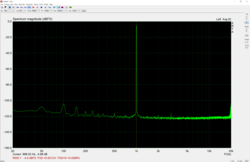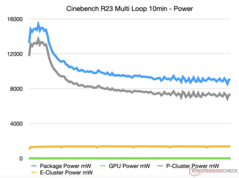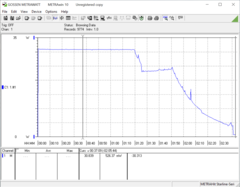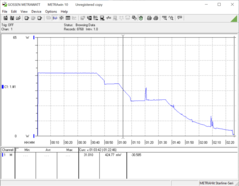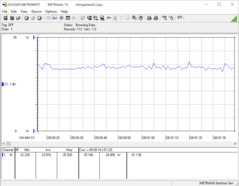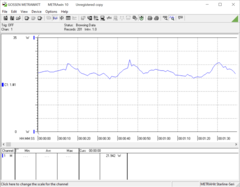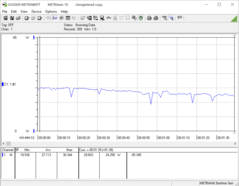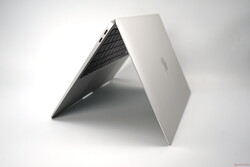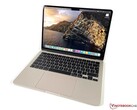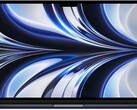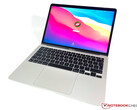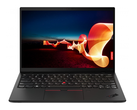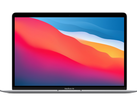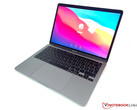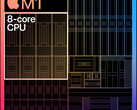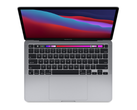Apple MacBook Air 2020 M1 Entry Review: Apple M1 CPU humbles Intel and AMD

After many years of rumors and an announcement in June, the time has finally come: With the new MacBook Pro 13 and the MacBook Air, we are testing two notebooks with the Apple M1 processor. The new Air is particularly exciting. While it offers the same powerful M1 SoC as the Pro model, it is quiet with its fanless cooling, and costs significantly less. You only have to accept a limitation of the integrated graphics card in the most affordable version, since Apple has deactivated one of the eight graphics cores. However, the maximum clock speeds of the GPU and CPU are comparable, and if necessary, you can get the eighth graphics core in the more expensive Air model with the larger SSD. For a hefty premium, you can also order the Apple M1 SoC with 16 GB of RAM. Because the RAM is placed on the same board right next to the SoC, it cannot be upgraded.
Two of the direct competitors come from Apple's own camp: The MacBook Pro 13 offers a fan for better performance under continuous load, a Touchbar, a larger battery (and also case), and a slightly brighter display. And positioned below the Air are the iPads with the optional keyboard cover / Magic Keyboard. For example, the recently updated iPad Air 4 with a Magic Keyboard presents itself as a more compact alternative. However, with the 256-GB version you are already in a comparable price range, and an iPad Pro with keyboard is even more expensive. But it has the advantage of optional pen operation. As a cheaper Apple alternative, we could also mention the iPad 4 with the keyboard cover.
There are numerous competitors among the Windows notebooks. You can find a constantly updated list of all the top competitors to the MacBook Air here. The device that is most well-known is the Dell XPS 13, whose newest version 9310 is also available with Tiger Lake.
We purchased our test unit from regular commercial sources, deciding for the most affordable entry-level version with a seven-core GPU, 256 GB SSD, and 8 GB of RAM in silver color.
Comparison of possible competitors
Rating | Date | Model | Weight | Height | Size | Resolution | Price |
|---|---|---|---|---|---|---|---|
| 91.1 % v7 (old) | 12 / 2020 | Apple MacBook Air 2020 M1 Entry M1, M1 7-Core GPU | 1.3 kg | 16.1 mm | 13.30" | 2560x1600 | |
| 88.1 % v7 (old) | 10 / 2020 | Dell XPS 13 9310 Core i7 FHD i7-1165G7, Iris Xe G7 96EUs | 1.3 kg | 14.8 mm | 13.40" | 1920x1200 | |
| 87.9 % v7 (old) | 10 / 2020 | Lenovo ThinkPad X13 Yoga 20SX0004GE i7-10510U, UHD Graphics 620 | 1.3 kg | 15.95 mm | 13.30" | 1920x1080 | |
| 88.8 % v7 (old) | 10 / 2019 | Lenovo ThinkPad X395 R3 PRO 3300U, Vega 6 | 1.3 kg | 16.9 mm | 13.30" | 1920x1080 | |
| 89.5 % v7 (old) | 08 / 2020 | Lenovo ThinkPad X13-20UGS00800 R7 PRO 4750U, Vega 7 | 1.3 kg | 16.9 mm | 13.30" | 1920x1080 | |
| 90.7 % v7 (old) | 11 / 2020 | Apple iPad Air 4 2020 A14, A14 Bionic GPU | 458 g | 6.1 mm | 10.90" | 2360x1640 | |
| 89.3 % v7 (old) | 05 / 2020 | Apple iPad Pro 12.9 2020 A12Z Bionic, A12Z Bionic GPU | 641 g | 5.9 mm | 12.90" | 2732x2048 | |
| 85.4 % v7 (old) | 10 / 2019 | Apple iPad 7 2019 A10 Fusion, A10 Fusion GPU | 483 g | 7.5 mm | 10.20" | 2160x1620 |
Case
To come to the point right away: there is nothing new in terms of the case. Apple was only concerned about inner values, and there are no external changes compared to the 2020 refresh of the MacBook Air. Only the large display bezels strike us as out of date. In the Windows world, those have already shrunk considerably (see XPS 13). You will also look in vain for a touchscreen, which might actually be quite useful due to the adjustments of Big Sur and the compatibility of IOS apps. On the other hand, the positive characteristics of the aluminum unibody case remain. It is very robust, feels high quality, and is attractive with its simple design. The Air is not considered an icon of style for nothing and was imitated by numerous manufacturers. Due to the case becoming slimmer, the sharp edges in front are not a problem - in contrast to the Pro models.
A minor detail on the side: The second MacBook Air in our test (more expensive model with octa-core GPU and 512 GB SSD) produces a slight squeak when moving the hinge. Our entry-level test unit does not show this behavior, and we also never encountered it in the many test units of the previous generations.
Looking at the competitors, it is obvious that the MacBook Air does not set new standards in terms of size and weight in 2020 anymore. There are some significantly slimmer and smaller notebooks. At a comparable weight, the Dell XPS 13 can score in all those measurements.
Connection Equipment
As usual, the MacBook Air offers only meager fare in terms of the connections. Fortunately, the two USB-C ports on the left side support Thunderbolt 3. However, the compatibility is not at the level we are used to from Intel based notebooks. First the positive: both ports can be used for charging and worked flawlessly in our test with various charging devices (MBP16, Anker, Philips USB-C Monitor). Both ports can also be used as DisplayPort, but the M1 in the MacBook Air only supports a single additional monitor. In our test, 4K at 60 Hz worked perfectly with the Philips Brilliance 329P9H and also with an LG 4K monitor. However, an Asus PB287Q only ran at 30 Hz in 4K, and you can also hear about some isolated problems in the Internet. At this point, external Thunderbolt accessories cannot be used reliably yet. External graphics cards are not supported yet (apparently it lacks an ARM driver for example from AMD, which was tested with the Mantiz Venus), and the Mantiz Titan TB Dock also worked only in parts at best and was unreliable. The data rates of USB 3.2 Gen 2 devices are also not comparable with those of Intel based Thunderbolt devices. Apparently USB 4 is only supported in the lowest version with 10 Gbit/s, but you can achieve higher data rates (for example, 15.4 Gbit/s in the network test) with Thunderbolt 3.
We should also not forget to mention the headset port on the right side, whose attractive quality we liked (more on that later).
Communication
With the move to the Apple M1, finally support for 802.11ax, also known as WiFi 6, has arrived. However, in the test with our Netgear Nighthawk Stream RAX120 router, the Air was only able to connect at 80 MHz and a maximum of 1200 Mbit/s. This led to very weak data rates for a WiFi 6 device in our test. In our comparison, the Asus PCE-AX58BT WiFi 6 card (which uses the Intel AX200 Chip) achieved 1.5 Gbit/s right after that. In the comparison of the competing notebooks, the XPS 13 had a significant advantage, for example. While there are hardly any advantages compared to the predecessor model (only Wifi 5), at least the MacBook Air is able to leave the iPad Air 4 slightly behind (probably because of better antennas).
Webcam
Unfortunately, not much has changed in terms of the webcam either. Apple continues to use the same mediocre camera module with a weak 720p resolution. At least the Apple M1 chip offers improved image processing, allowing for colors and contrast to also turn out better. Depending on the situation, this can be quite noticeable.
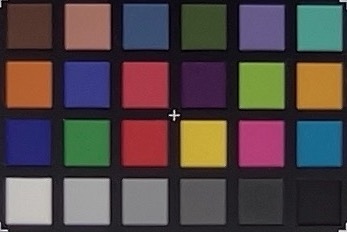
Maintenance
The bottom of the laptop continues to be secured with Pentalobe screws. However, there are hardly any reasons for wanting to access the insides, since only the battery can be replaced relatively easily. There is no fan needing maintenance, and all the components such as the CPU, GPU, SSD, RAM, and WLAN card are directly soldered onto the main board. Our colleges from iFixit have already taken the device apart and shown the differences to the old Air.
Warranty
Apple offers a one-year warranty for all its products, including a phone hotline (also for software problems). For a longer warranty period, you have the option to purchase the expensive warranty extension called Apple Care (also including the hotline).
Input Devices
Keyboard
The mechanics of the keyboard have not changed compared to the predecessor model. Apple uses the good scissor keys that are appreciated much more by the majority of users and also supposed to be more reliable. At 89 WPM in the fast type test, the author achieved a very good result without any time to familiarize himself (even though he was a fan of the old butterfly keys). So the stroke, size, and layout continue to be ideal for Apple users. As before, Windows users have to readjust, and the lack of labeling on some special keys (such as the brackets []{} in the German layout) continues to be annoying.
Compared to the MacBook Pro 13, the Air has to make do without the Touchbar, offering the traditional F1 - F12 function keys instead. Unless you want to use the Touchbar for Widgets, this is not a great disadvantage.
Touchpad
There are also no changes here, but we wouldn't know what you could improve here anyways. The glass touchpad with its vibration motor works perfectly up to the corners. The touchpad continues to be without equal in the Windows world. In the larger notebook models, Apple only changes the size of the trackpad, but it is much better compared to the Magic Keyboard of the iPad series.
Display
According to Apple, there are also some small changes in the display. While it still uses the same 16:10 resolution with 2560 x 1600 pixels, it now offers a slightly increased maximum brightness and a larger color space. We confirmed the higher brightness. In our comparison of the competitors, the iPads are significantly brighter and the XPS 13 is also able to produce a noticeably higher maximum brightness. As usual, the ThinkPads are unfortunately defeated in this discipline. The relatively high black value unfortunately leads only to an average contrast of 1000:1.
| |||||||||||||||||||||||||
Brightness Distribution: 91 %
Center on Battery: 417 cd/m²
Contrast: 1069:1 (Black: 0.39 cd/m²)
ΔE ColorChecker Calman: 1.12 | ∀{0.5-29.43 Ø4.78}
calibrated: 0.77
ΔE Greyscale Calman: 1.7 | ∀{0.09-98 Ø5}
99.8% sRGB (Calman 2D)
85.9% AdobeRGB 1998 (Argyll 3D)
100% sRGB (Argyll 3D)
98.6% Display P3 (Argyll 3D)
Gamma: 2207
CCT: 6870 K
| Apple MacBook Air 2020 M1 Entry IPS, 2560x1600, 13.3" | Dell XPS 13 9310 Core i7 FHD Sharp LQ134N1, IPS, 1920x1200, 13.4" | Lenovo ThinkPad X13 Yoga 20SX0004GE N133HCG-GR3, IPS, 1920x1080, 13.3" | Lenovo ThinkPad X395 LP133WF7-SPB1, IPS, 1920x1080, 13.3" | Lenovo ThinkPad X13-20UGS00800 B133HAK01.1, IPS LED, 1920x1080, 13.3" | Apple iPad Air 4 2020 IPS, 2360x1640, 10.9" | Apple iPad Pro 12.9 2020 Liquid Retina Display, IPS, 2732x2048, 12.9" | Apple iPad 7 2019 IPS, 2160x1620, 10.2" | |
|---|---|---|---|---|---|---|---|---|
| Display | -15% | -18% | -21% | -21% | ||||
| Display P3 Coverage (%) | 98.6 | 70.9 -28% | 67.2 -32% | 64.1 -35% | 64.8 -34% | |||
| sRGB Coverage (%) | 100 | 99.1 -1% | 98.1 -2% | 95.2 -5% | 95.6 -4% | |||
| AdobeRGB 1998 Coverage (%) | 85.9 | 72.9 -15% | 69 -20% | 65.8 -23% | 65.7 -24% | |||
| Response Times | -48% | -44% | -50% | -49% | -25% | -22% | 4% | |
| Response Time Grey 50% / Grey 80% * (ms) | 31 ? | 52 ? -68% | 56 ? -81% | 55 ? -77% | 56.8 ? -83% | 46.8 ? -51% | 46.8 ? -51% | 38 ? -23% |
| Response Time Black / White * (ms) | 26.1 ? | 33.2 ? -27% | 28 ? -7% | 32 ? -23% | 30 ? -15% | 25.6 ? 2% | 24.4 ? 7% | 18 ? 31% |
| PWM Frequency (Hz) | 118000 ? | 2475 ? | 58820 ? | |||||
| Screen | -56% | -12% | -46% | -110% | 3% | 10% | 11% | |
| Brightness middle (cd/m²) | 417 | 543.3 30% | 401 -4% | 356 -15% | 331 -21% | 509 22% | 625 50% | 499 20% |
| Brightness (cd/m²) | 395 | 524 33% | 383 -3% | 336 -15% | 315 -20% | 486 23% | 599 52% | 470 19% |
| Brightness Distribution (%) | 91 | 92 1% | 91 0% | 88 -3% | 90 -1% | 93 2% | 87 -4% | 87 -4% |
| Black Level * (cd/m²) | 0.39 | 0.38 3% | 0.16 59% | 0.16 59% | 0.21 46% | 0.39 -0% | 0.47 -21% | 0.49 -26% |
| Contrast (:1) | 1069 | 1430 34% | 2506 134% | 2225 108% | 1576 47% | 1305 22% | 1330 24% | 1018 -5% |
| Colorchecker dE 2000 * | 1.12 | 3.02 -170% | 2.6 -132% | 3.6 -221% | 6.1 -445% | 1.3 -16% | 1.3 -16% | 0.97 13% |
| Colorchecker dE 2000 max. * | 2.71 | 7.61 -181% | 4.2 -55% | 5.5 -103% | 10 -269% | 2.8 -3% | 2.7 -0% | 1.98 27% |
| Colorchecker dE 2000 calibrated * | 0.77 | 1.23 -60% | 0.9 -17% | 1.11 -44% | 1.2 -56% | |||
| Greyscale dE 2000 * | 1.7 | 5 -194% | 3.3 -94% | 4.7 -176% | 6.3 -271% | 2.2 -29% | 1.8 -6% | 0.9 47% |
| Gamma | 2207 0% | 2.02 109% | 2.01 109% | 2.92 75% | 2.77 79% | 2.21 100% | 2.23 99% | 2.135 103% |
| CCT | 6870 95% | 6550 99% | 6076 107% | 6222 104% | 6938 94% | 6833 95% | 6765 96% | 6571 99% |
| Color Space (Percent of AdobeRGB 1998) (%) | 66.8 | 62.7 | 61 | 60.7 | 99.3 | |||
| Color Space (Percent of sRGB) (%) | 99.6 | 98.1 | 96 | 95.4 | ||||
| Total Average (Program / Settings) | -40% /
-46% | -25% /
-18% | -39% /
-41% | -60% /
-82% | -11% /
-3% | -6% /
4% | 8% /
10% |
* ... smaller is better
The color accuracy of the panel is excellent in our tests. The color tests as well as the grayscale are significantly better than with the Windows competitors. The display is therefore very well suited for photographers and others using applications that are dependent on color accuracy. However, they should also test and recalibrate their display regularly. In this regard, we then found out, for example, that older hardware was not supported anymore, and that there might be some compatibility problems with the M1.
The sRGB color space is practically covered completely and DCI P3 (under daVinci Resolve), to 98.2%. As usual, tests via MobileForge or the browser only run in the sRGB color space. The i1Profiler calibration software of the i1pro is currently not compatible with the M1 Macs, therefore we used the SyperX to calibrate the display (measurements still done with the i1pro).
The display is protected by reflective glass as usual. There is, however, a special layer on top that is supposed to reduce annoying reflections. But you should definitely still avoid bright light sources from behind. The brightness is also only sufficient for shady conditions, and things become difficult in direct sunlight.
To save energy, Apple uses PWM at a very high frequency of 117 kHz for brightness up to about 50% (about 160 cd/m2). Above that, we measure some slight flickering at 60 Hz, but this only shows some very small brightness variations (with or without the charger). Neither should lead to any difficulties for more than very few users.
The response times of the display are good for an IPS display, but only average when considering all the displays we tested. However, there are no limitations at all in everyday operation.
Display Response Times
| ↔ Response Time Black to White | ||
|---|---|---|
| 26.1 ms ... rise ↗ and fall ↘ combined | ↗ 14.9 ms rise | |
| ↘ 11.2 ms fall | ||
| The screen shows relatively slow response rates in our tests and may be too slow for gamers. In comparison, all tested devices range from 0.1 (minimum) to 240 (maximum) ms. » 64 % of all devices are better. This means that the measured response time is worse than the average of all tested devices (20.2 ms). | ||
| ↔ Response Time 50% Grey to 80% Grey | ||
| 31 ms ... rise ↗ and fall ↘ combined | ↗ 14 ms rise | |
| ↘ 17 ms fall | ||
| The screen shows slow response rates in our tests and will be unsatisfactory for gamers. In comparison, all tested devices range from 0.165 (minimum) to 636 (maximum) ms. » 40 % of all devices are better. This means that the measured response time is similar to the average of all tested devices (31.6 ms). | ||
Screen Flickering / PWM (Pulse-Width Modulation)
| Screen flickering / PWM detected | 118000 Hz | ≤ 49 % brightness setting | |
| ≤ 155 cd/m² brightness | |||
The display backlight flickers at 118000 Hz (worst case, e.g., utilizing PWM) Flickering detected at a brightness setting of 49 % (155 cd/m²) and below. There should be no flickering or PWM above this brightness setting. The frequency of 118000 Hz is quite high, so most users sensitive to PWM should not notice any flickering. Flickering occurs even at high brightness setting and may have an effect on the user during everyday use. In comparison: 53 % of all tested devices do not use PWM to dim the display. If PWM was detected, an average of 8098 (minimum: 5 - maximum: 343500) Hz was measured. | |||
Performance
The most important innovation is of course the Apple M1 SoC. With this, Apple integrates its own processor and graphics units also in notebooks for the first time. Because the architecture has changed from x86 to ARM, old programs have to be emulated (Rosetta 2) under MacOS, causing some loss in performance. On the other hand, you gain compatibility to IOS programs, which run without emulation. Unfortunately, some manufacturers lock their apps for usage under MacOS, so that the whole software library of the iPads will not be available. The lack of a touchscreen is also a point here. Directly integrated into the chip, you can also find the LPDDR4X-4266 main storage as Unified Memory with either 8 or 16 GB. An advantage of the Unified Memory architecture is the fact that the CPU and GPU are able to access the memory simultaneously without the need of copying shared elements (as was the case until now).
Processor
The integrated processor in the M1 SoC is the most important innovation. It offers four fast and large Firestorm cores with a clock speed of up to 3.2 GHz (P Cluster) and four energy saving cores with the codename Icestorm (up to 2.1 GHz, E Cluster). While all eight cores can be used simultaneously, only the Icestorm cores run under low loads, ensuring a long battery life. In contrast to the MacBook Pro, there is no fan in the Air but only a passive cooling block instead. This has a significant effect under longer loads. We therefore have to differentiate in our tests now: either native execution or Rosetta 2 emulation and short or longer loads.
In the Cinebench loops, the throttling of the M1 immediately becomes apparent. After the first run, the performance in Cinebench R23 drops by 8%, and then levels out at a 12% reduction after six runs. For passive cooling and the high level of performance, this really isn't bad. The MacBook Pro 13 is able to maintain its performance thanks to the active fans. In the comparison with the Intel competitors, the M1 is even able to perform in Rosetta 2 emulated benchmarks at the level of a Tiger Lake i7-1165G7. Compared to the old MacBook Air (even with a Core i5), the M1 plays in a different league - very impressive!
Cinebench R15 loop (emulated via Rosetta 2)
Cinebench R23 loop (native)
Cinebench R20: CPU (Single Core) | CPU (Multi Core)
Cinebench R15: CPU Single 64Bit | CPU Multi 64Bit
Blender: v2.79 BMW27 CPU
7-Zip 18.03: 7z b 4 -mmt1 | 7z b 4
Geekbench 5.5: Single-Core | Multi-Core
R Benchmark 2.5: Overall mean
| Performance rating | |
| Average of class Subnotebook | |
| Average Apple M1 | |
| Intel Reference Design Laptop 28W -2! | |
| Lenovo ThinkPad X13-20UGS00800 | |
| Apple MacBook Air 2020 M1 Entry | |
| Razer Blade Stealth i7-1165G7 GTX 1650 Ti Max-Q | |
| Dell XPS 13 9310 Core i7 FHD | |
| Lenovo ThinkPad X13 Yoga 20SX0004GE | |
| Apple MacBook Air 2020 i5 | |
| Apple MacBook Air 2020 i3 | |
| Cinebench R20 / CPU (Single Core) | |
| Average of class Subnotebook (128 - 826, n=69, last 2 years) | |
| Intel Reference Design Laptop 28W | |
| Razer Blade Stealth i7-1165G7 GTX 1650 Ti Max-Q | |
| Dell XPS 13 9310 Core i7 FHD | |
| Lenovo ThinkPad X13-20UGS00800 | |
| Lenovo ThinkPad X13 Yoga 20SX0004GE | |
| Average Apple M1 (401 - 406, n=4) | |
| Apple MacBook Air 2020 M1 Entry | |
| Apple MacBook Air 2020 i5 | |
| Apple MacBook Air 2020 i5 | |
| Apple MacBook Air 2020 i3 | |
| Cinebench R20 / CPU (Multi Core) | |
| Average of class Subnotebook (579 - 8541, n=69, last 2 years) | |
| Lenovo ThinkPad X13-20UGS00800 | |
| Intel Reference Design Laptop 28W | |
| Average Apple M1 (1863 - 2109, n=4) | |
| Razer Blade Stealth i7-1165G7 GTX 1650 Ti Max-Q | |
| Dell XPS 13 9310 Core i7 FHD | |
| Apple MacBook Air 2020 M1 Entry | |
| Lenovo ThinkPad X13 Yoga 20SX0004GE | |
| Apple MacBook Air 2020 i5 | |
| Apple MacBook Air 2020 i5 | |
| Apple MacBook Air 2020 i3 | |
| Cinebench R15 / CPU Single 64Bit | |
| Average of class Subnotebook (72.4 - 322, n=69, last 2 years) | |
| Intel Reference Design Laptop 28W | |
| Razer Blade Stealth i7-1165G7 GTX 1650 Ti Max-Q | |
| Dell XPS 13 9310 Core i7 FHD | |
| Apple MacBook Air 2020 M1 Entry | |
| Average Apple M1 (206 - 208, n=3) | |
| Lenovo ThinkPad X13-20UGS00800 | |
| Lenovo ThinkPad X13 Yoga 20SX0004GE | |
| Apple MacBook Air 2020 i3 | |
| Apple MacBook Air 2020 i5 | |
| Blender / v2.79 BMW27 CPU | |
| Apple MacBook Air 2020 i3 | |
| Apple MacBook Air 2020 i5 | |
| Lenovo ThinkPad X13 Yoga 20SX0004GE | |
| Apple MacBook Air 2020 M1 Entry | |
| Dell XPS 13 9310 Core i7 FHD | |
| Razer Blade Stealth i7-1165G7 GTX 1650 Ti Max-Q | |
| Average Apple M1 (412 - 710, n=2) | |
| Intel Reference Design Laptop 28W | |
| Lenovo ThinkPad X13-20UGS00800 | |
| Average of class Subnotebook (159 - 2271, n=72, last 2 years) | |
| 7-Zip 18.03 / 7z b 4 -mmt1 | |
| Average of class Subnotebook (2643 - 6442, n=71, last 2 years) | |
| Apple MacBook Air 2020 M1 Entry | |
| Average Apple M1 (n=1) | |
| Intel Reference Design Laptop 28W | |
| Dell XPS 13 9310 Core i7 FHD | |
| Razer Blade Stealth i7-1165G7 GTX 1650 Ti Max-Q | |
| Lenovo ThinkPad X13 Yoga 20SX0004GE | |
| Lenovo ThinkPad X13-20UGS00800 | |
| Apple MacBook Air 2020 i5 | |
| Apple MacBook Air 2020 i3 | |
| Geekbench 5.5 / Single-Core | |
| Average of class Subnotebook (726 - 2350, n=64, last 2 years) | |
| Average Apple M1 (1710 - 1745, n=9) | |
| Apple MacBook Air 2020 M1 Entry | |
| Razer Blade Stealth i7-1165G7 GTX 1650 Ti Max-Q | |
| Dell XPS 13 9310 Core i7 FHD | |
| Lenovo ThinkPad X13 Yoga 20SX0004GE | |
| Apple MacBook Air 2020 i5 | |
| Apple MacBook Air 2020 i5 | |
| Lenovo ThinkPad X13-20UGS00800 | |
| Apple MacBook Air 2020 i3 | |
| Geekbench 5.5 / Multi-Core | |
| Average of class Subnotebook (2557 - 17218, n=64, last 2 years) | |
| Apple MacBook Air 2020 M1 Entry | |
| Average Apple M1 (7034 - 7710, n=9) | |
| Dell XPS 13 9310 Core i7 FHD | |
| Lenovo ThinkPad X13-20UGS00800 | |
| Razer Blade Stealth i7-1165G7 GTX 1650 Ti Max-Q | |
| Lenovo ThinkPad X13 Yoga 20SX0004GE | |
| Apple MacBook Air 2020 i5 | |
| Apple MacBook Air 2020 i5 | |
| Apple MacBook Air 2020 i3 | |
| R Benchmark 2.5 / Overall mean | |
| Apple MacBook Air 2020 i5 | |
| Apple MacBook Air 2020 i5 | |
| Apple MacBook Air 2020 i3 | |
| Apple MacBook Air 2020 M1 Entry | |
| Average Apple M1 (n=1) | |
| Lenovo ThinkPad X13 Yoga 20SX0004GE | |
| Lenovo ThinkPad X13-20UGS00800 | |
| Dell XPS 13 9310 Core i7 FHD | |
| Intel Reference Design Laptop 28W | |
| Razer Blade Stealth i7-1165G7 GTX 1650 Ti Max-Q | |
| Average of class Subnotebook (0.403 - 1.456, n=70, last 2 years) | |
* ... smaller is better
System Performance
Since there are no classic system benchmarks such as the PCMark from UL under Mac OS X, we use the browser benchmarks here. Apple's own Safari browser offers an outstanding Javascript performance, and in combination with the fast M1 SoC, RAM, and SSD, the MacBook Air produces top values here.
If we consider the WebXPRT 3, which is often used by Intel for comparisons, we can see that even the fast Core i7-1185G7 and also i7-10900K processors (desktop) are left behind. Ahead of the M1, we can only find the new Zen 3 based desktop CPUs with high clock speeds (such as the Ryzen 9 5950X).
In well-optimized apps, the M1 SoC is also able to take advantage of the additional dedicated functional units (video decoding, AI acceleration, encryption). In this way, it is able to process 4K videos (of the correct format) smoothly in Final Cut X from Apple, for example.
| WebXPRT 3 - Overall | |
| Average of class Subnotebook (156 - 482, n=68, last 2 years) | |
| Apple MacBook Air 2020 M1 Entry | |
| Apple MacBook Air 2020 M1 Entry | |
| AMD Radeon RX 6800 XT | |
| Intel Reference Design Laptop 28W | |
| Intel Reference Design Laptop 15W | |
| MSI Prestige 14 Evo A11M-056US | |
| Dell XPS 13 9310 Core i7 FHD | |
| Lenovo Yoga Slim 7-14ARE | |
| Lenovo ThinkPad X13-20UGS00800 | |
| Apple iPad Air 4 2020 | |
| Apple iPad Pro 12.9 2020 | |
| Samsung Galaxy Book S | |
| Apple iPad 7 2019 | |
| Mozilla Kraken 1.1 - Total | |
| Samsung Galaxy Book S | |
| Apple iPad 7 2019 | |
| Lenovo ThinkPad X13 Yoga 20SX0004GE | |
| Lenovo Yoga Slim 7-14ARE | |
| Lenovo ThinkPad X13-20UGS00800 | |
| Apple iPad Pro 12.9 2020 | |
| Dell XPS 13 9310 Core i7 FHD | |
| MSI Prestige 14 Evo A11M-056US | |
| Intel Reference Design Laptop 15W | |
| AMD Radeon RX 6800 XT | |
| Average of class Subnotebook (265 - 1104, n=73, last 2 years) | |
| Apple MacBook Air 2020 M1 Entry | |
| Apple MacBook Air 2020 M1 Entry | |
| Apple iPad Air 4 2020 | |
| Speedometer 2.0 - Result 2.0 | |
| Average of class Subnotebook (110 - 793, n=37, last 2 years) | |
| Apple MacBook Air 2020 M1 Entry | |
| Apple MacBook Air 2020 M1 Entry | |
| Apple iPad Air 4 2020 | |
| MSI Prestige 14 Evo A11M-056US | |
| Apple iPad Pro 12.9 2020 | |
| Apple iPad 7 2019 | |
| Samsung Galaxy Book S | |
| Jetstream 2 - 2.0 Total Score | |
| Average of class Subnotebook (117 - 441, n=38, last 2 years) | |
| Apple MacBook Air 2020 M1 Entry | |
| Apple MacBook Air 2020 M1 Entry | |
| MSI Prestige 14 Evo A11M-056US | |
| Apple iPad Air 4 2020 | |
| Lenovo ThinkPad X13-20UGS00800 | |
| Apple iPad Pro 12.9 2020 | |
| Apple iPad 7 2019 | |
| Samsung Galaxy Book S | |
| Youtube - 2160p60 CPU Load | |
| Apple MacBook Air 2020 M1 Entry (5) | |
| Average of class Subnotebook (1 - 27, n=56, last 2 years) | |
| Lenovo ThinkPad X13-20UGS00800 (68, 2) | |
| Lenovo Yoga Slim 7-14ARE (66) | |
| Dell XPS 13 9310 Core i7 FHD (31, 2) | |
* ... smaller is better
Storage Solution
The Air also achieves a huge jump ahead with the SSD, almost catching up with the current MacBook Pro 16 - note that this is the entry-level model with 256 GB versus the 1 TB SSD for an additional premium.
Graphics Card
Unfortunately, you won't get the full graphics performance of the M1 chip in the entry-level model of the MacBook Air, but you have to make do without one of the eight cores. This also makes the performance noticeably slower than that of the more expensive devices. Despite that, the performance is still excellent compared to the predecessor devices and also the iPads. The performance is at a comparable level as that of the Radeon Pro 5300M in the most affordable MacBook Pro 16.
Gaming Performance
In the gaming performance, macOS isn't able to keep up with Windows devices. Most of the games are only ports of their Windows version, so they already lose some of their optimizations and performance in this process. In better optimized games such as "Borderlands 3," the M1 GPU achieves about the performance of a GeForce MX350 under Windows. It is, however, able to leave the integrated Intel graphics cards significantly behind.
Despite the very good performance, we still see many compatibility problems with the new graphics chip. At 8x AA, Unigine Valley displays only a black screen, "Borderlands 3" leaves a black screen after closing it (sometimes even requiring a reboot), "Counter-Strike: GO" doesn't start, and "Total War: Three Kingdoms" has some texture errors and we noticed several more details in the test.
In addition, numerous IOS games can also run. But you won't find popular and demanding games such as "Call of Duty Mobile" or "PUBG Mobile" in the App Store at this point. Since the theoretical raw performance (see GFXBench and 3DMark) lies significantly above that of the fastest iPads, you shouldn't have any performance problems here, and the architecture is also the same. In our test, this is proven by "World of Tanks Blizz," for example, which runs smoothly at maximum details (high incl. 4x AA) and in native resolution, and even on an external 4K monitor at 60 fps.
In terms of throttling and performance in battery operation, we can also reassure you: During 20 minutes of stress test, the 3DMark Wild Life measurements did not show any performance drops (99% stability), and the GFXBench Metal Manhattan test also ran with stable frame rates in battery operation (unfortunately at limited 60 fps).
| low | med. | high | ultra | QHD | 4K | |
|---|---|---|---|---|---|---|
| Batman: Arkham City (2011) | 86 | 47 | ||||
| Counter-Strike: GO (2012) | 109 | 69 | 44.4 | |||
| Deus Ex Mankind Divided (2016) | 47.6 | 35.3 | 19 | |||
| Civilization 6 (2016) | 80.3 | 30.1 | 27 | 15.8 | ||
| Warhammer 40.000: Dawn of War III (2017) | 43.9 | 32.5 | ||||
| F1 2017 (2017) | 60 | 54 | 43 | |||
| Shadow of the Tomb Raider (2018) | 65 | 22 | ||||
| Total War: Three Kingdoms (2019) | 95 small graphical problems (smog not perfect) | 26 small graphical problems (smog not perfect) | 17 small graphical problems | |||
| Borderlands 3 (2019) | 45.2 | 28 | 17.7 | |||
| Hearthstone (2020) | 58 | |||||
| Cyberpunk 2077 (2023) | 17.8 |
Emissions
Noise Emissions
The cooling of the small MacBook Air is fully passive, and its operation is therefore completely silent. Our test unit did not produce any audible coil whine or transistor noises either.
Temperature
The passive cooling and excellent performance gives rise to some apprehension about the surface temperatures. However, we can also reassure you here. Even though the hotspot above the computing unit can become quite hot during longer-lasting load, all the important places where the notebook is touched remain comfortably cool. In regular load situations, the Air even remains particularly cool, which is a sign of the great efficiency of the Apple M1.
As is typical for Apple, the internal temperatures often approach the limits. The GPU in particular reaches 87 °C (189 °F) in "Mankind Divided," for example, with the speed leveling out at 790 MHz and a consumption of 2.8 watts. The whole SoC reports 87 °C (189 °F). In the extreme load test with Cinebench R15 and Unigine Valley, the GPU even reaches 97 °C (207 °F), with the SoC again reporting 87 °C and the SSD, 52 °C (126 °F).
(±) The maximum temperature on the upper side is 44 °C / 111 F, compared to the average of 35.9 °C / 97 F, ranging from 21.4 to 59 °C for the class Subnotebook.
(±) The bottom heats up to a maximum of 44 °C / 111 F, compared to the average of 39.3 °C / 103 F
(+) In idle usage, the average temperature for the upper side is 25.8 °C / 78 F, compared to the device average of 30.8 °C / 87 F.
(+) The palmrests and touchpad are reaching skin temperature as a maximum (32 °C / 89.6 F) and are therefore not hot.
(-) The average temperature of the palmrest area of similar devices was 28.2 °C / 82.8 F (-3.8 °C / -6.8 F).
Speaker
Our audio measurements produce a minimally better result than for the old MacBook Air, but whether the difference is caused by the new components inside (no fan, more resonance space) or our new, improved microphone for the measurements, is not clear. What remains is the excellent impression - particularly considering the build. While the more expensive MacBooks are able to achieve a better result, the Air strikes a great figure in the comparison of the competitors.
The headset port also received a welcome and significant improvement with the M1 upgrade. The results of the measurement are very good, and the subjective audio quality using JBL Club headphones (on loan from Intel Tiger Lake) is also flawless.
Apple MacBook Air 2020 M1 Entry audio analysis
(±) | speaker loudness is average but good (79.6 dB)
Bass 100 - 315 Hz
(±) | reduced bass - on average 7.1% lower than median
(±) | linearity of bass is average (9.5% delta to prev. frequency)
Mids 400 - 2000 Hz
(+) | balanced mids - only 2.2% away from median
(+) | mids are linear (5.3% delta to prev. frequency)
Highs 2 - 16 kHz
(+) | balanced highs - only 2.3% away from median
(+) | highs are linear (4% delta to prev. frequency)
Overall 100 - 16.000 Hz
(+) | overall sound is linear (8.7% difference to median)
Compared to same class
» 3% of all tested devices in this class were better, 1% similar, 96% worse
» The best had a delta of 5%, average was 18%, worst was 53%
Compared to all devices tested
» 2% of all tested devices were better, 1% similar, 97% worse
» The best had a delta of 4%, average was 24%, worst was 134%
Apple MacBook 12 (Early 2016) 1.1 GHz audio analysis
(+) | speakers can play relatively loud (83.6 dB)
Bass 100 - 315 Hz
(±) | reduced bass - on average 11.3% lower than median
(±) | linearity of bass is average (14.2% delta to prev. frequency)
Mids 400 - 2000 Hz
(+) | balanced mids - only 2.4% away from median
(+) | mids are linear (5.5% delta to prev. frequency)
Highs 2 - 16 kHz
(+) | balanced highs - only 2% away from median
(+) | highs are linear (4.5% delta to prev. frequency)
Overall 100 - 16.000 Hz
(+) | overall sound is linear (10.2% difference to median)
Compared to same class
» 7% of all tested devices in this class were better, 2% similar, 91% worse
» The best had a delta of 5%, average was 18%, worst was 53%
Compared to all devices tested
» 4% of all tested devices were better, 1% similar, 94% worse
» The best had a delta of 4%, average was 24%, worst was 134%
Power Management
Power Consumption
The MacBook Air shows very good values in the power consumption from the outlet for the class of subnotebooks. We are seeing values here that are all comparable across the board to those of the Acer Swift 3 SF313-52-z1Y7 with the Ice Lake i7-1065G7, for example. The values are also very similar to those from the old Intel based MacBook Air notebooks that still had to be cooled actively, and only weak devices with the Pentium N5000 or Celeron SoCs and small screens show significantly better values. Only the Samsung Galaxy Book S with an ARM based Snapdragon 8cx is much more efficient. While the Intel Lakefield version also consumes less power, it is not to the same extent as the 8cx.
Using the included small 30-watt charger, the battery is completely recharged from 0 to 100% in 2h 40min. If you use the more powerful charger of the MacBook Pro 16, the time it takes to recharge is shortened by 17 minutes, since it initially delivers significantly more power (see chart below).
| Off / Standby | |
| Idle | |
| Load |
|
Key:
min: | |
| Apple MacBook Air 2020 M1 Entry M1, M1 7-Core GPU, Apple SSD AP0256Q, IPS, 2560x1600, 13.3" | Samsung Galaxy Book S Intel i5-L16G7, UHD Graphics G7 (Lakefield GT2 64 EU), 256 GB UFS 3.0 Flash, IPS, 1920x1080, 13.3" | Samsung Galaxy Book S SD 8cx, Adreno 680, 256 GB NVMe, IPS, 1920x1080, 13.3" | Acer Swift 3 SF313-52-71Y7 i7-1065G7, Iris Plus Graphics G7 (Ice Lake 64 EU), Intel SSD 660p 1TB SSDPEKNW010T8, IPS, 2256x1504, 13.5" | Dell XPS 13 9310 Core i7 FHD i7-1165G7, Iris Xe G7 96EUs, Micron 2300 512GB MTFDHBA512TDV, IPS, 1920x1200, 13.4" | Average of class Subnotebook | |
|---|---|---|---|---|---|---|
| Power Consumption | 16% | 33% | 9% | -41% | -68% | |
| Idle Minimum * (Watt) | 1.9 | 2.5 -32% | 1.61 15% | 1.8 5% | 3.9 -105% | 4.01 ? -111% |
| Idle Average * (Watt) | 6.4 | 4.8 25% | 4.3 33% | 4.6 28% | 5.9 8% | 6.87 ? -7% |
| Idle Maximum * (Watt) | 7 | 6 14% | 5 29% | 6.1 13% | 6.3 10% | 8.49 ? -21% |
| Load Average * (Watt) | 25 | 14.9 40% | 13.2 47% | 27.4 -10% | 39.7 -59% | 44.4 ? -78% |
| Load Maximum * (Watt) | 30.3 | 20.1 34% | 18.3 40% | 27 11% | 47.5 -57% | 67.9 ? -124% |
| Witcher 3 ultra * (Watt) | 34.8 |
* ... smaller is better
Battery Life
The small subnotebook with the M1 processor is able to score in terms of the battery life. It clearly surpasses the old MacBook Air based on the Core i5 in the browsing test at 150 cd/m² of brightness, and in the subnotebook class there are really only the new MacBook Pro 13 and the Asus ExpertBook B9450FA that are better. Surprisingly, the battery life with Safari in full-screen mode is not significantly longer anymore, but it even got slightly shorter.
At maximum brightness, we only measure 8.5 hours in our WLAN script test. The efficient SoC matters less here, and the bright display demands its due. However, the test still shows that you can easily last through a working day without a charger under moderate load.
Things look worse if you want to play games while on the road. With the Unigine Valley Extreme (with 4x AA) benchmark, it lasted only 2 hours and 23 minutes at maximum brightness. While there are several notebooks in the Windows world that last longer, none of them offer a comparable graphics performance.
| Apple MacBook Air 2020 M1 Entry M1, M1 7-Core GPU, 49.9 Wh | Dell XPS 13 9310 Core i7 FHD i7-1165G7, Iris Xe G7 96EUs, 52 Wh | Lenovo ThinkPad X13 Yoga 20SX0004GE i7-10510U, UHD Graphics 620, 50 Wh | Lenovo ThinkPad X395 R3 PRO 3300U, Vega 6, 48 Wh | Lenovo ThinkPad X13-20UGS00800 R7 PRO 4750U, Vega 7, 48 Wh | Apple iPad Air 4 2020 A14, A14 Bionic GPU, 28.6 Wh | Apple iPad Pro 12.9 2020 A12Z Bionic, A12Z Bionic GPU, 36.71 Wh | Apple iPad 7 2019 A10 Fusion, A10 Fusion GPU, 32.4 Wh | Apple MacBook Air 2020 i5 i5-1030NG7, Iris Plus Graphics G7 (Ice Lake 64 EU), 49.9 Wh | Average of class Subnotebook | |
|---|---|---|---|---|---|---|---|---|---|---|
| Battery runtime | ||||||||||
| WiFi v1.3 (h) | 16 | 11 -31% | 8.2 -49% | 10.9 -32% | 8.7 -46% | 11.7 -27% | 15.1 -6% | 11.8 -26% | 10.3 -36% | 13.4 ? -16% |
Pros
Cons
Verdict
The new M1 processor with ARM architecture makes an impressive debut in the MacBook Air. In CPU as well as GPU performance, comparable chips from Intel and AMD are surpassed in terms of the theoretical raw performance - and this is the entry-level configuration of the Air. The passive cooling hardly impacts the everyday performance, the graphics performance does not drop noticeably over time, and only during demanding tasks for the processor there is a noticeable drop after several minutes. But at 11%, this also remains within limits. We can also reassure you about the surface temperatures, with only the internals getting very hot, as is typical for Apple. A huge advantage of the lack of a fan is the silent operation of the notebook, which is perfect in quiet surroundings. The new Apple M1 also has a positive effect on the battery life. With its energy-saving cores, it is able to save a lot of power in our WLAN battery test, and it can even last through a full work day at maximum display brightness.
However, the change to the Apple in-house chips does not only bring advantages. Many older apps have to run via Rosetta 2 emulation and significantly lose in performance. On the other hand, the emulation is fast enough to still get better results than when using the old entry-level processors from Intel. Unfortunately, not everything works perfectly yet. From stuttering interfaces and longer load times up to app crashes, there are many open problems. So you have to hope for native versions of the software or updates from Apple. Buyers should find out in advance whether the software they use could run into trouble or whether there are alternatives. However, any limitations in the app selection from this are balanced by the numerous newly added iOS apps that will run perfectly thanks to the ARM chip.
The new Apple chips celebrate a successful debut in the MacBook Air. With maturing software, probably no one will miss the Intel chips in the Mac in the future.
The case and the display remained practically unchanged. Here we would have wished at least for a touchscreen - particularly because of the iOS compatibility - and smaller display bezels. Otherwise there are no reasons for complaint at all in terms of the case, input devices, and speakers.
In terms of its price, the entry level is particularly attractive, especially since there are always some good offers from vendors over the years. The additional charge for the octa-core GPU and 16 GB of RAM are not necessarily worthwhile, and the fast 8 GB of Unified RAM should be completely sufficient for most users. The 256-GB SSD represents more of a limitation, and the premiums for more storage space are very hefty. The additional charge for the MacBook Pro 13 with active cooling is also only worthwhile for very few users. Active cooling, a larger battery, a slightly brighter display, and a Touchbar only really matter to very few people. And power users should better wait anyway for the M1X in more powerful models, where you can also hope for more than only 2 TB3 ports.
Price and Availability
The new MacBook Air with the M1 chip is already available starting from about 1,000 USD from Amazon (free shipping), among other places.
Apple MacBook Air 2020 M1 Entry
- 12/18/2020 v7 (old)
Klaus Hinum




